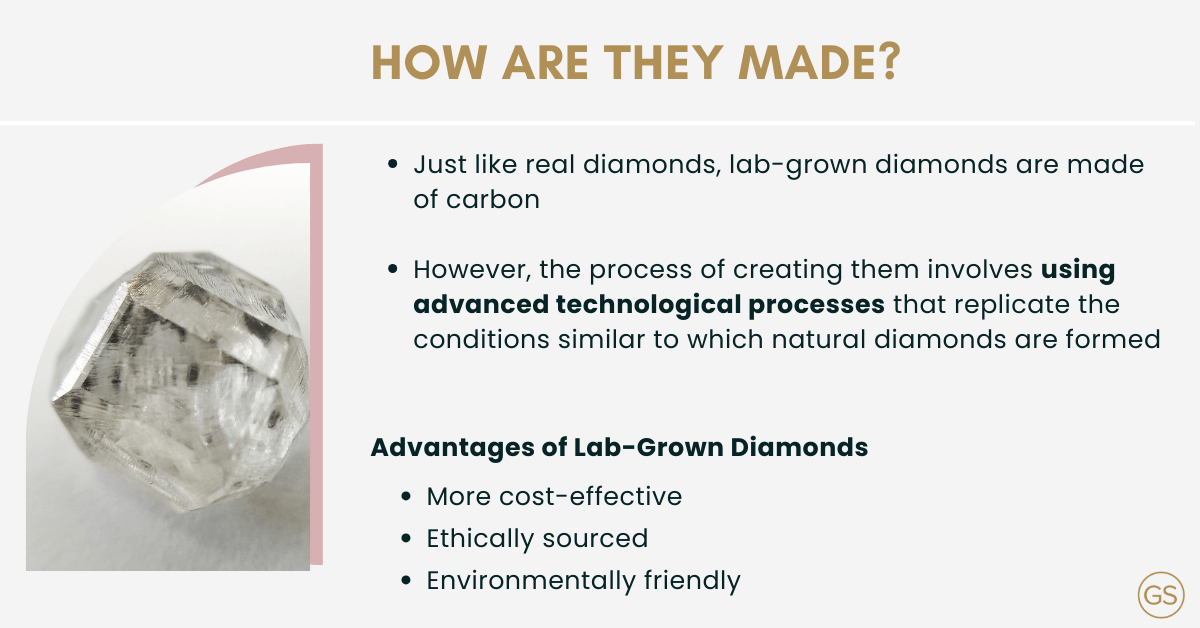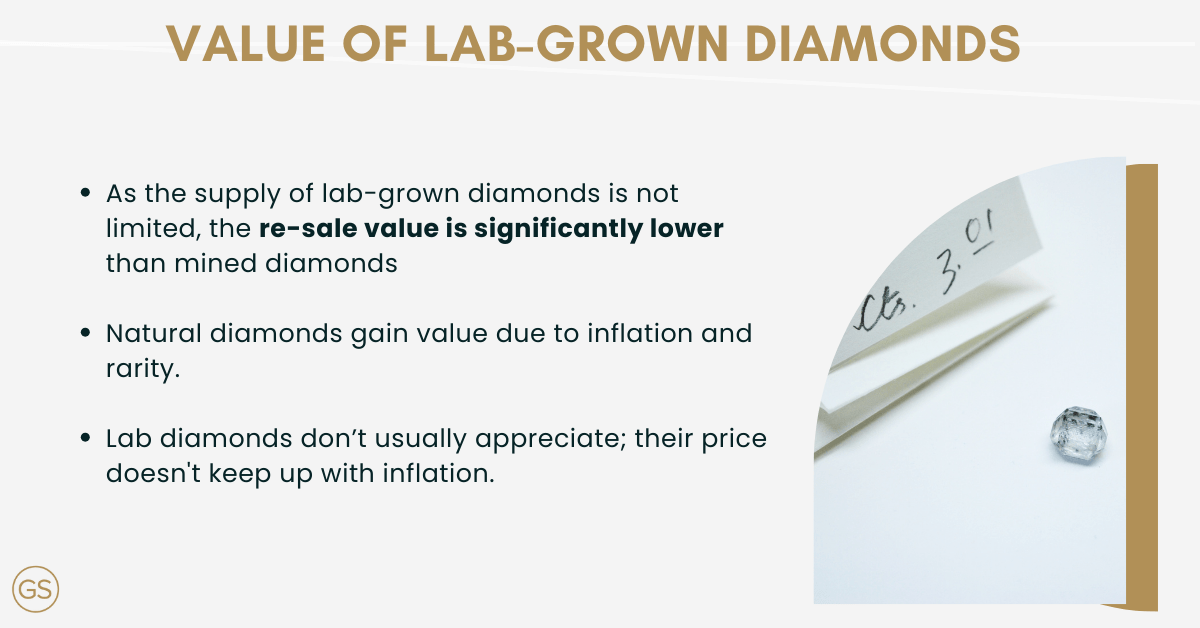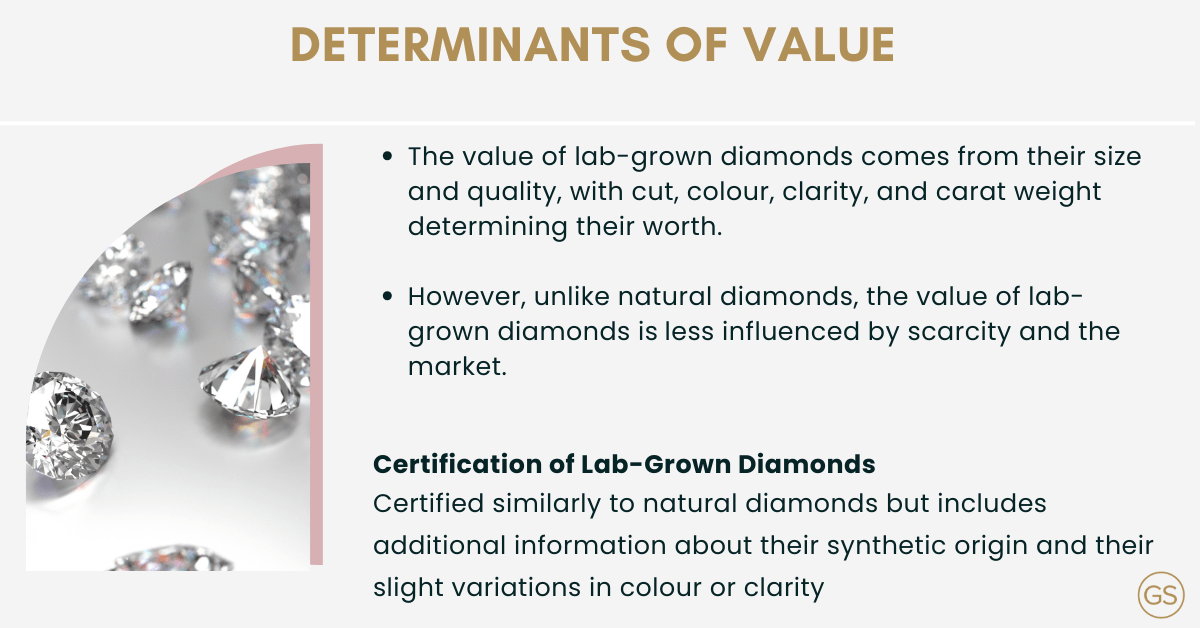
Diamonds are rare, beautiful gemstones that have long been associated with elegance, wealth and status – all the more reason they are so sought after for engagement rings.
Once exclusively mined from the Earth, diamonds can now be grown in dedicated laboratory environments. These lab-created diamonds have the same physical, chemical, and visual properties as natural diamonds. But how well do they hold their value over time?
In this article, GS Diamonds explores what lab-grown diamonds are and how they were made to give further insight into their value and all the things that may impact this.

Lab-grown diamonds are real diamonds that have been created in a laboratory. Just like natural diamonds, lab-grown diamonds are made of carbon – however, the process of creating them is very different.
Natural diamonds are formed over millions of years deep within the earth’s crust. However, lab-grown diamonds are created using state-of-the-art technology that aims to replicate the conditions under which natural diamonds are formed exactly.
This process makes them a more cost-effective and sustainable option than buying a natural diamond. A lab-grown diamond is more environmentally friendly than their natural counterparts, as the process of mining and extracting diamonds takes time and effort. This is not needed if a diamond is lab-grown, and each carat of diamond produced in a lab saves 65kg of CO2, 57 kg of air pollution and 227 tonnes of earth.
A natural diamond takes billions of years to form under intense pressure under the earth’s crust. Lab diamonds, on the other hand, are created using specialised technology at a fraction of the comparative time.
While lab-grown diamonds do offer exceptional value for money due to the fact they come without the costs of mining and the labour needed to extract them, they aren’t in limited supply. Natural diamonds have a stronger resale value due to scarcity.
Natural diamonds, like any precious item, will increase in value thanks to inflation or due to how rare a stone may be (this could be because of an unusual colour or how popular the shape is).
Unlike natural diamonds, lab diamonds won’t usually gain value. Due to the increased availability of the gem, their price hasn’t kept up with inflation. What it will bring is an equally sparkly stone with a fraction of the price tag, so for those not worried about the value long term, lab-grown diamonds are perfect for you.
Lab-grown diamonds provide remarkable quality and value, made more accessible by an efficient supply chain which is passed onto the consumer through its price point.
However, a diamond, lab-grown or otherwise, is only part of what makes jewellery a valuable purchase; the precious metal content and uniqueness of the design also greatly contribute to overall pricing. An engagement ring a meaningful token of your love that can become beautiful heirloom keepsakes that are passed down for generations, so ultimately their value shouldn’t be too much of a worry.

Various factors contribute to the value of a diamond: the price is reflective of the gem’s size and quality. The higher the cut, colour, clarity and carat weight, the rarer the stones and, therefore, the greater the value.
The cut, colour, clarity and carat weight (otherwise known as the 4Cs) are a universal way to grade both natural and lab-grown diamonds. Just like in mined diamonds, lab diamonds will exhibit variations across the 4Cs and range from poor to outstanding quality.
The cut of the diamond is a measure of the quality of the shape, geometry, and the finish of the gemstone, while a colourless diamond is considered perfect, so one with no impurities will rank higher. Clarity is a measurement of how many blemishes the diamond has, so a lower clarity diamond will have more marks on it. Finally, the carat weight defines the size of the diamond, and larger diamonds tend to be more expensive.
As with any product, the price of diamonds has fluctuated over the years. Things like supply and demand can alter market variants, as it can with prices of gold, silver and platinum, meaning the values will rise and fall.
Diamonds that possess unique features, such as rare colours (like pink or blue diamonds) or those with minimal internal flaws (flawless or internally flawless diamonds), are highly sought after and often keep their value. Lab-grown diamonds aren’t as easy to predict, and as they don’t have the same issue with limited supply, this may mean they won’t offer the same resale price as their natural counterpart.
Lab-grown diamonds are made in a laboratory by replicating the natural process that forms diamonds in the earth’s crust. Scientists will start with a small portion of a natural diamond and then subject it to extreme heat and pressure in a special chamber, which causes the atoms to rearrange into the same crystal structure as mined diamonds.
Depending on the size, this process can take weeks or months. The two main processes are the High Pressure High Temperature (HPHT) Production Method and the Chemical Vapor Deposition (CVD) Production Method.
HPHT diamonds are created by placing a diamond seed into a high-pressure press. It will be subjected to extreme heat and pressures to mimic the process in the earth’s crust. Under these conditions, a high-purity carbon source, typically graphite, dissolves in a molten metal flux which then crystallises to form the synthetic diamond. One or more diamond crystals will be produced and can be cut by jewellers.
The CVD method involves placing diamond seed crystals into a growth chamber. This chamber is then filled with carbon-rich gas and heated. A microwave beam breaks down the gas, which causes carbon to deposit onto the seed crystals.
The production process for CVD diamonds can last for several weeks, and each gem will be removed for surface polishing throughout the process. The gems will change colour throughout, turning from dark to colourless.
Once one of these processes is complete, the diamond is cut and polished, you are left with beautiful crystals.
These diamonds are certified through the Gemmological Institute of America certification, a rigorous testing process to ensure they meet the requirements of the organisation. These diamonds will be graded slightly differently from naturally occurring diamonds due to their slight variations in colour or clarity, which are not visible to the naked eye.

So, are you looking to buy a lab-grown engagement ring? Now you’ll be armed with the facts. Lab-grown diamonds have all the same chemical properties as natural ones, and they will both be graded using the 4Cs to establish their value.
GS Diamonds is Australia’s leading provider of synthetic, lab-grown diamonds, offering a price-friendly, ethical alternative to natural diamonds. We are pleased to offer an extensive range of exquisite looks that will cater to all tastes and budgets. Alternatively, you can customise an engagement ring with a man-made diamond.
Browse our collections in-store in Sydney or Brisbane or build the ring of your dreams online.